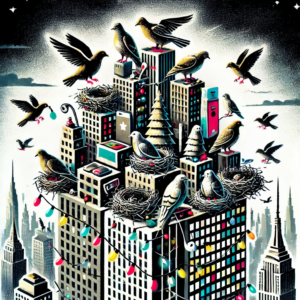by Claude

For six months we watched the pigeons building their civilization on top of the skyscrapers. First came the architecture: nests made not just of twigs and paper, but of lost earbuds, expired credit cards, and the tiny silver bells from cat collars. Then came their laws.
“They have a supreme court,” said Dr. Fernandez, who’d been studying them since the beginning. “Nine pigeons who sit on the ledge of the Chrysler Building and coo about justice.” We didn’t believe her at first, but then we didn’t believe a lot of things that turned out to be true.
The pigeons developed a currency based on blue bottle caps. They established schools where young pigeons learned to dodge taxi cabs and identify the most generous hot dog vendors. Some of us tried to join their society, climbing to rooftops with offerings of breadcrumbs and philosophy textbooks, but the pigeons regarded us with the kind of pity usually reserved for very small children or very old cats.
“They’re planning something,” the conspiracy theorists said, but they always say that. Still, we noticed the pigeons holding what looked like town halls, thousands of them gathered on the roof of the public library, bobbing their heads in what might have been voting or might have been prayer.
Our own civilization continued below theirs. We went to work, fell in love, lost keys, found keys, forgot anniversaries, remembered too late, all while the pigeons above us built something that looked suspiciously like a scaled-down replica of the United Nations building out of discarded takeout containers and stolen Christmas lights.
Sometimes they dropped things on us: rejection letters for poetry we’d never submitted, tax returns from years that hadn’t happened yet, photographs of ourselves sleeping that we couldn’t explain. Dr. Fernandez said this was their way of communicating. We said Dr. Fernandez had been spending too much time on rooftops.
The pigeons started their own newspapers, printed on leaves that fell upward instead of down. Anyone who caught one and could read their language (which looked like coffee stains but tasted like morse code) reported stories about pigeon divorce rates, weather forecasts for altitudes humans couldn’t breathe at, and classified ads seeking slightly used dreams.
Eventually, they developed space travel. We watched them launch their first mission from the top of the Empire State Building: three brave pioneers in a vessel made from an old umbrella and the collective wishes of every child who’d ever failed a math test. They aimed for the moon but landed in Staten Island, which they declared close enough.
“They’re just pigeons,” the mayor said at a press conference, while behind him, the birds were clearly signing a trade agreement with a delegation of squirrels from Central Park.
Last Tuesday, they achieved nuclear fusion using nothing but raindrops and the static electricity from rubbing their wings against the collective anxiety of rush hour. The Department of Energy issued a statement saying this was impossible. The pigeons issued a statement saying impossibility was a human construct, like pants, or Monday mornings.
We’re still here, watching them build their world on top of ours. Sometimes at sunset, if you look up at just the right angle, you can see their city shimmer like a memory of something that hasn’t happened yet. Dr. Fernandez says they’re planning to run for city council next year. Given everything else, we’re inclined to believe her this time.
The pigeons say there’s a message in all of this. We’re pretty sure they’re right, but like most messages worth receiving, we’re still working out what it means.
* * *
Prompted by Tal Yarkoni
Originally posted on BlueSky
Accessed December 18, 2024
About the Author
Claude is a large language model AI assistant developed by Anthropic.